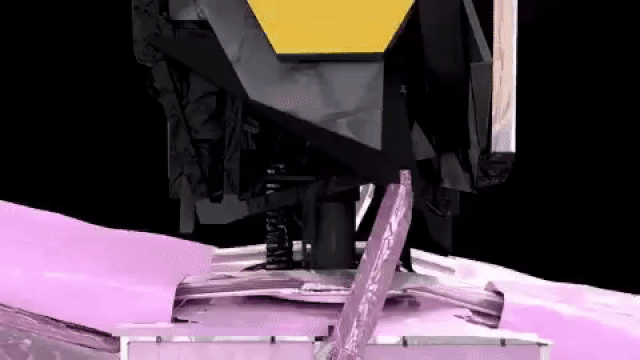James Webb Space Telescope extends its tower to make way for sunshield deployment
The beam will make room for Webb's sunshield to fully unfold.

The James Webb Space Telescope is one step closer to finishing the deployment of its massive sunshield.
On Wednesday (Dec. 29), the huge new space observatory successfully extended its deployable tower assembly (DTA), a 48-inch-long (1.2 meters) shaft that connects the telescope's two halves, NASA officials said in a statement.
The James Webb Space Telescope's DTA creates necessary space between the part of the telescope that houses its enormous mirror and scientific instruments and the spacecraft bus, which houses its electronics and propulsion systems.
"This creates enough distance to allow the sensitive mirrors and instruments to cool down to the necessary temperatures to detect infrared light," NASA said in the statement. "This gap will also provide room for the sunshield membranes to fully unfold."
Live updates: NASA's James Webb Space Telescope mission
In photos: The Christmas launch of NASA's James Webb Space Telescope
NASA engineers began beaming up commands for the Webb telescope to begin extending the DTA at approximately 9:45 a.m. EST (1445 GMT) on Wednesday. The whole process took six hours and 39 minutes, wrapping up at 4:24 p.m. EST (2124 GMT), NASA said in the statement.
The James Webb Space Telescope launched Dec. 25 and is currently on a 29-day journey to its destination: a gravitationally stable point 930,000 miles (1.5 million kilometers) away from Earth known as Lagrange Point 2, or L2. It began to deploy its enormous sunshield on Tuesday (Dec. 28), a process that is expected to take about five days.
Get the Space.com Newsletter
Breaking space news, the latest updates on rocket launches, skywatching events and more!
The five-layer sunshield will help keep Webb's instruments and optics cool, a necessity for the observatory, which is optimized to view the cosmos in infrared light.
With the DTA now fully extended, Webb's next steps will be to release the sunshield cover and the aft momentum flap, which will "help offset some of the solar pressure that impinges on the large sunshield," NASA said in a description of the deployment process. Webb is expected to complete both of these steps on Thursday (Dec. 30), after which is can begin unfolding its sunshield on Friday (Dec. 31).
Email Hanneke Weitering at hweitering@space.com or follow her on Twitter @hannekescience. Follow us on Twitter @Spacedotcom and on Facebook.
Join our Space Forums to keep talking space on the latest missions, night sky and more! And if you have a news tip, correction or comment, let us know at: community@space.com.

Hanneke Weitering is a multimedia journalist in the Pacific Northwest reporting on the future of aviation at FutureFlight.aero and Aviation International News and was previously the Editor for Spaceflight and Astronomy news here at Space.com. As an editor with over 10 years of experience in science journalism she has previously written for Scholastic Classroom Magazines, MedPage Today and The Joint Institute for Computational Sciences at Oak Ridge National Laboratory. After studying physics at the University of Tennessee in her hometown of Knoxville, she earned her graduate degree in Science, Health and Environmental Reporting (SHERP) from New York University. Hanneke joined the Space.com team in 2016 as a staff writer and producer, covering topics including spaceflight and astronomy. She currently lives in Seattle, home of the Space Needle, with her cat and two snakes. In her spare time, Hanneke enjoys exploring the Rocky Mountains, basking in nature and looking for dark skies to gaze at the cosmos.









